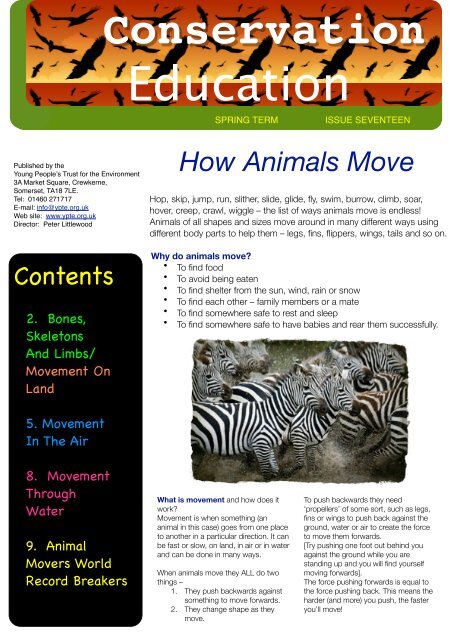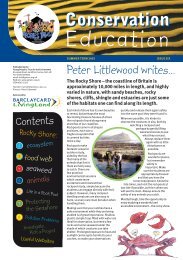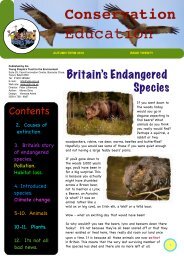How Animals Move - Young People's Trust for the Environment
How Animals Move - Young People's Trust for the Environment
How Animals Move - Young People's Trust for the Environment
- No tags were found...
You also want an ePaper? Increase the reach of your titles
YUMPU automatically turns print PDFs into web optimized ePapers that Google loves.
Conservation EducationSPRING TERM ISSUE SEVENTEENPublished by <strong>the</strong><strong>Young</strong> People’s <strong>Trust</strong> <strong>for</strong> <strong>the</strong> <strong>Environment</strong>3A Market Square, Crewkerne,Somerset, TA18 7LE.Tel: 01460 271717E-mail: info@ypte.org.ukWeb site: www.ypte.org.ukDirector: Peter LittlewoodContents2. Bones,SkeletonsAnd Limbs/<strong>Move</strong>ment OnLand<strong>How</strong> <strong>Animals</strong> <strong>Move</strong>Hop, skip, jump, run, sli<strong>the</strong>r, slide, glide, fly, swim, burrow, climb, soar,hover, creep, crawl, wiggle – <strong>the</strong> list of ways animals move is endless!<strong>Animals</strong> of all shapes and sizes move around in many different ways usingdifferent body parts to help <strong>the</strong>m – legs, fins, flippers, wings, tails and so on.Why do animals move?• To find food• To avoid being eaten• To find shelter from <strong>the</strong> sun, wind, rain or snow• To find each o<strong>the</strong>r – family members or a mate• To find somewhere safe to rest and sleep• To find somewhere safe to have babies and rear <strong>the</strong>m successfully.5. <strong>Move</strong>mentIn The Air8. <strong>Move</strong>mentThroughWater! !! ! !9. Animal<strong>Move</strong>rs WorldRecord BreakersWhat is movement and how does itwork?<strong>Move</strong>ment is when something (ananimal in this case) goes from one placeto ano<strong>the</strong>r in a particular direction. It canbe fast or slow, on land, in air or in waterand can be done in many ways.When animals move <strong>the</strong>y ALL do twothings –1. They push backwards againstsomething to move <strong>for</strong>wards.2. They change shape as <strong>the</strong>ymove.To push backwards <strong>the</strong>y need‘propellers’ of some sort, such as legs,fins or wings to push back against <strong>the</strong>ground, water or air to create <strong>the</strong> <strong>for</strong>ceto move <strong>the</strong>m <strong>for</strong>wards.[Try pushing one foot out behind youagainst <strong>the</strong> ground while you arestanding up and you will find yourselfmoving <strong>for</strong>wards].The <strong>for</strong>ce pushing <strong>for</strong>wards is equal to<strong>the</strong> <strong>for</strong>ce pushing back. This means <strong>the</strong>harder (and more) you push, <strong>the</strong> fasteryou’ll move!
Legless!Even vertebrates with no legs, such as snakes, can move around very well on land:• They have very strong muscles running down along <strong>the</strong>ir bodies that areattached to hundreds of ribs.• These muscles work by leng<strong>the</strong>ning down one side and shortening on <strong>the</strong>o<strong>the</strong>r, which makes <strong>the</strong> snake’s body move side to side with a <strong>for</strong>wardpush.• The scales on <strong>the</strong> snake’s skin help <strong>the</strong>m to grip <strong>the</strong> ground.• If <strong>the</strong>re was no roughness on <strong>the</strong> ground (e.g. like glass) snakes wouldslide around all over <strong>the</strong> place and not get anywhere!You may be wondering why snakes don’t have legs. Millions of years ago <strong>the</strong>irancestors did have legs. But some species probably began burrowing into <strong>the</strong>ground to live, where legs weren’t much use so <strong>the</strong>y slowly lost <strong>the</strong>m. Even thoughmany snakes live above ground now, <strong>the</strong> legs have never come back!Boa constrictorJungle LifeMany vertebrates that live in <strong>the</strong> Tropical Rain<strong>for</strong>ests have speciallegs or feet to help <strong>the</strong>m move about in amongst all those treesand leaves:Orang utan• Gibbons from SE Asia swing through <strong>the</strong> trees with <strong>the</strong>irlong arms, hand over hand, from branch to branch. Theycan do this as fast as a running adult human!• Gibbons and Orangutans have feet like hands that can gripbranches too.• Spider Monkeys and chameleons have muscley tails thatcan grip branches. These are called ‘prehensile’ tails.• Tree Frogs have pads on <strong>the</strong>ir toes that give off a stickyliquid, like glue.• Each Gecko’s foot touches down in 100 million places!They have scales and hairs on <strong>the</strong> bottom that act likesuckers. If you try to pull a gecko off a sheet of glass, <strong>the</strong>ygrip so well <strong>the</strong> glass may break be<strong>for</strong>e you can get <strong>the</strong>gecko off!• Sifakas, a type of lemur from Madagascar, have legs thatare much longer than <strong>the</strong>ir arms. They find it easier tobounce from one leg to ano<strong>the</strong>r while holding <strong>the</strong>ir armshigh in <strong>the</strong> air! This looks very funny to us.• Down by <strong>the</strong> river, <strong>the</strong> Jacana, or ‘Lily Trotter’, is a bird thatcan walk on lily leaves without sinking. Their toes are verylong and spread wide, so <strong>the</strong>ir weight is spread over a bigarea. They also tread very gently!Polar LifeMoving around on icy, snowy ground can be very tricky.<strong>How</strong> do animals manage it?• Polar bears have very large feet to stop <strong>the</strong>msinking in <strong>the</strong> snow – <strong>the</strong>ir weight is spread over awider area.• Their feet have big, bristly pads underneath, tohelp <strong>the</strong>m grip on <strong>the</strong> ice.• The polar bear’s large feet also make excellentpaddles <strong>for</strong> swimming.• Penguins sometimes find it easier to slide on <strong>the</strong>irbellies in <strong>the</strong> snow and ice, ra<strong>the</strong>r than walk, if itis too slippery.
Desert LifeMoving around in <strong>the</strong> desert can be tricky too. Theground can get extremely hot, or <strong>the</strong> sand can be verydeep and difficult to move on. Some vertebrates havecome up with some clever ways of avoiding burnttoes, or that sinking feeling!• Camels have two big, wide ‘toes’ on each footthat spread <strong>the</strong>ir weight in <strong>the</strong> sand to stop <strong>the</strong>msinking.• Kangaroo rats from North America have long,•springy back legs, so <strong>the</strong>y can leap greatdistances quickly in loose sand to avoid predators,or to get to <strong>the</strong> shade.Golden moles have big front paws and claws soNamib gecko<strong>the</strong>y can ‘swim’ under <strong>the</strong> sand, where it’s coolerand safer. They can dig a tunnel 4km (2.5 miles) long in one night!• The Namib gecko has webbed feet – not <strong>for</strong> swimming but to stop it sinking in <strong>the</strong> sand.• Sidewinder snakes throw <strong>the</strong>ir bodies in s-shaped loops to keep as much of <strong>the</strong>ir bodies off <strong>the</strong>hot ground as possible. This leaves strange tracks in <strong>the</strong> sand.• The Bearded lizard ‘dances’ on two legs at a time to keep <strong>the</strong>m off <strong>the</strong> hot ground. The ones in<strong>the</strong> air cool off, while <strong>the</strong> o<strong>the</strong>rs are down on <strong>the</strong> hot sand.Mini-movers95% of <strong>the</strong> Earth’s animals are minibeasts, many of which creep, crawl, wriggle or sli<strong>the</strong>r on land. They can haveanything from 0 to 400 legs with a variety of methods of movement. Minibeasts don’t have a spine and bones in askeleton, like <strong>the</strong> vertebrates – some of <strong>the</strong>m, like flies, have a casing (an exoskeleton) on <strong>the</strong> outside of <strong>the</strong>irbodies; o<strong>the</strong>rs, like worms and slugs, are soft and have no exoskeleton. All of <strong>the</strong>m have muscles on <strong>the</strong>ir bodiesto help <strong>the</strong>m move. We call this group of animals <strong>the</strong> invertebrates.• Millipedes may have up to 400 legs, but <strong>the</strong>y are still slow movers because <strong>the</strong>ir legs are only very shortand <strong>the</strong>ir bodies long and very close to <strong>the</strong> ground. Their legs move in waves along <strong>the</strong> body, taking carenot to trip up!• Slugs and snails have one muscle called <strong>the</strong> ‘foot’ under <strong>the</strong>ir bodies, that contracts and expands to help<strong>the</strong>m move <strong>for</strong>wards. The slime on <strong>the</strong>ir bodies helps <strong>the</strong>m slide along more easily and it’s sticky so <strong>the</strong>ycan climb up walls.• Worms have muscles in rings around <strong>the</strong>ir bodies and long ones down along <strong>the</strong>ir bodies. They work as ateam to push and pull <strong>the</strong> worm along. Bristles on <strong>the</strong> worm help grip <strong>the</strong> soil around it.• Looping caterpillars only have legs at each end of <strong>the</strong>ir bodies, not in <strong>the</strong> middle, to help <strong>the</strong>m grip, loop,grip, loop!• Springtails have a sort of tight spring under <strong>the</strong>ir tails, that releases suddenly to help <strong>the</strong>m jump – ra<strong>the</strong>rlike a pogo stick!• O<strong>the</strong>r insects, like ants and spiders, have legs with joints that make climbing and clinging easier.Millipede
Furry FliersBats are <strong>the</strong> only mammals that can truly fly. Thereare approximately 1000 species of bats on Earth.Bats’ wings are very different from birds’ wings. Theyare membranes of skin stretched between <strong>the</strong> frontand back legs, ra<strong>the</strong>r like an umbrella. Bats are justlike mice that have developed wings and can now fly!Bats beat <strong>the</strong>ir wings up and down like birds and canreach speeds of up to 56kph (35mph).Did You Know?A fruit bat has a 2m wing spanFruit batsPhony FliersSome animals are called ‘flying’ but <strong>the</strong>y can’t actually fly properly. Flying Squirrels have skinbetween <strong>the</strong>ir front and back legs and <strong>the</strong>y glide between trees, a bit like using a parachute.Paradise tree snakes are excellent gliders, but <strong>the</strong>y don’t have skin flaps – <strong>the</strong>y hollow out <strong>the</strong>ir lowerbody to <strong>for</strong>m a kind of parachute and wiggle <strong>the</strong>ir tail like a rudder.Flying fish appear to fly above water to escape predators below. What <strong>the</strong>y are actually doing iswagging <strong>the</strong>ir tails really fast just in <strong>the</strong> water and using <strong>the</strong>ir front fins like wings to move through <strong>the</strong>air.Humming birdO<strong>the</strong>r minibeasts can move through <strong>the</strong> air without actually flying.Spiders, <strong>for</strong> example, can’t fly (phew!) but baby ones often use silk‘parachutes’ to float on <strong>the</strong> breeze to find new places to live.Did You Know?! Some butterflies flap <strong>the</strong>ir wings 100 times persecond! North American Monarch butterflies fly nearly2000km (1200 miles) to Mexico <strong>for</strong> <strong>the</strong> winter.Mini fliersSeveral types of minibeasts havewings and can fly. Some of <strong>the</strong>se havetwo wings (flies) and some have four(e.g. bees, butterflies).• Bees and wasps hook <strong>the</strong>irfront and back wings toge<strong>the</strong>r• Butterflies have four wings butfly as if <strong>the</strong>y only have two• Dragonflies also have fourwings but <strong>the</strong>y can move eachwing independently. Thismeans <strong>the</strong>y can dartbackwards and <strong>for</strong>wards veryfast and to stop suddenly.• The front pair of wings onbeetles is a horny shield thatprotects <strong>the</strong> delicate backwings, which <strong>the</strong>y use <strong>for</strong>flying.• Insect wings are kept strongby blood in <strong>the</strong> veins.• Ants only have wings <strong>for</strong> ashort time – when <strong>the</strong>y arefully-grown and ready to find amate. After mating <strong>the</strong>y lose<strong>the</strong>ir wings; sometimes <strong>the</strong>ychew <strong>the</strong>m off!
<strong>Move</strong>ment through water is harder than walking on land or flying, because water causes ‘drag’, which slows animalsdown. So animals that live in water have to be able to move smoothly through it and be able to control <strong>the</strong>ir depth, so<strong>the</strong>y don’t sink to <strong>the</strong> very bottom or stay right near <strong>the</strong> surface. They also need some sort of mechanism <strong>for</strong> moving<strong>for</strong>wards.<strong>Move</strong>ment Through WaterIt’s a fishy business….We all know fish can swim, but how do <strong>the</strong>y do it?Ra<strong>the</strong>r than legs or wings, fish have fins and a tail to push against <strong>the</strong> water to make <strong>the</strong>m move <strong>for</strong>wards, to steerand brake. Fins also prevent <strong>the</strong> fish from rolling over and swinging from side to side too much. Fish have strongmuscles to control <strong>the</strong> fins and a good, streamlined shape, which is smooth and pointed, like a mini torpedo.• To control <strong>the</strong>ir depth, fish have a ‘swim bladder’ with air in, which <strong>the</strong>y can fill to float up and let out to sinkdown.• If sharks stop swimming <strong>the</strong>y sink!• Rays, which are ra<strong>the</strong>r like flattened sharks, have huge fins that look more like wings and <strong>the</strong>y appear to ‘fly’underwater.Not just fish…..Many o<strong>the</strong>r kinds of animals are good swimmers too.• Dolphins and whales (which are mammals) have flippers and tails much like fish, except <strong>the</strong>ir tails are flattenedhorizontally and swish up and down, whereas fishes’ tails are vertical and swish side to side.• Dolphins leap out of <strong>the</strong> water <strong>for</strong> several reasons. Firstly, <strong>the</strong>y cannot brea<strong>the</strong> underwater, so <strong>the</strong>y have tocome to <strong>the</strong> surface <strong>for</strong> air. It is also easier to move through air than water, so <strong>the</strong>y can save energy if <strong>the</strong>yleap out every now and <strong>the</strong>n.• Squid and octopuses squirt water out of a siphon (tube) at <strong>the</strong>ir rear end to move <strong>for</strong>ward – at speeds up to135kph (85mph)! To change direction <strong>the</strong>y simply squirt ano<strong>the</strong>r way.• Turtles have flippers, which <strong>the</strong>y use <strong>for</strong> swimming and dragging <strong>the</strong>mselves around on sand. In water, <strong>the</strong>irfront flippers are <strong>for</strong> moving <strong>for</strong>wards and <strong>the</strong>ir back flippers are <strong>for</strong> steering.• Some birds are excellent underwater swimmers, like <strong>the</strong> flightless penguins. They use <strong>the</strong>ir wings as flippers<strong>for</strong> swimming and <strong>the</strong>y leap out of water like dolphins to help <strong>the</strong>m go faster. They often pop out of <strong>the</strong> wateronto <strong>the</strong> ice like a cork – this means <strong>the</strong>y can land feet first and escape predators quickly.• O<strong>the</strong>r birds swim well on <strong>the</strong> surface, like ducks. They have webbed feet, like divers’ flippers, to help <strong>the</strong>mpaddle against <strong>the</strong> water.• Snakes can be excellent swimmers – <strong>the</strong>y wriggle from side to side and often have flattened sides that actlike paddles.Did You Know?! The Blue Marlin fish swims 10 times faster than <strong>the</strong> human Olympic swimming champion.! A flying squid can jet propel itself out of water onto a ship’s deck – eek!! Mud skipper fish can walk on land using <strong>the</strong>ir tough front fins like crutches.! The seahorse is <strong>the</strong> only type of fish with a prehensile tail, so it can grip weed and anchor itself.Mini swimmersMany small invertebrates live in water, and several of <strong>the</strong>m are larvae or pupae (young) of adults. They have a varietyof ways of moving around underwater- here are some examples:• Water boatmen have an extra long pair of legs that <strong>the</strong>y use like oars <strong>for</strong> ‘rowing’.• Dragonfly nymphs squirt water from <strong>the</strong>ir rear ends <strong>for</strong> jet propulsion.• Limpets cling to rocks with a strong ‘foot’, which acts like a sucker. When <strong>the</strong> tide is in and <strong>the</strong>y areunderwater, <strong>the</strong>y move around on <strong>the</strong> rocks like snails.• Starfish (not fish at all, but a type of invertebrate) have thousands of tiny tube feet on each of <strong>the</strong>ir five arms.Each tube is like a small balloon filled with seawater, ending in a sucker. The feet get longer as more watergoes in, which makes <strong>the</strong> suckers grip, and shorter when <strong>the</strong>re’s less water in <strong>the</strong>m, which means <strong>the</strong>suckers can let go.Walking on water?Pond Skaters really can walk on water. They spread <strong>the</strong>ir long thin legs wide over <strong>the</strong> water surface to spread <strong>the</strong>irweight. The water surface is a bit like custard skin, so <strong>the</strong> pond skater’s legs don’t fall through.
Animal <strong>Move</strong>rs: World RecordBreakers!Peregrine falcon• The fastest creature on <strong>the</strong> planet is a Peregrine falcon – it can reach speeds of 350kph (217mph) in a stoop(dive).• The fastest bird flying in a straight line is <strong>the</strong> swift – more than 160kph (100mph)!• The fastest animal on land is <strong>the</strong> cheetah, which can run at 96kph (60mph) flat out (but not <strong>for</strong> long)• The fastest snake was recorded sli<strong>the</strong>ring at 10kph (6mph)• The fastest lizard was running at 26kph (16mph)• The fastest creature in water is <strong>the</strong> Sailfish – it can swim up to 107kph (67mph)!•The fastest mammal in <strong>the</strong> sea is <strong>the</strong> Orca (Killer Whale) – 55kph (34mph )•The deepest diving penguin is <strong>the</strong> Emperor Penguin – one was recordeddiving to a depth of 260m and it was underwater <strong>for</strong> 18 minutes.Mole•The fastest running bird is <strong>the</strong> Ostrich (100m in 5 seconds)•The fastest snail (not many have been tested!) was <strong>the</strong> garden snail at awhopping 0.05kph (0.03mph)!•The slowest animal is thought to be <strong>the</strong> mole – it would take 8 hoursto travel 100m.•The slowest flying bird ever recorded was a swift – it was onlytraveling 19kph (12mph) whilst feeding•The lightest flying bird is <strong>the</strong> Ruby-throated Hummingbird, whichweighs just 4g•The heaviest flying bird is <strong>the</strong> Kori Bustard from Africa – <strong>the</strong>y canweigh up to 14kg – <strong>the</strong>y only fly short distances in emergencies!Conservation Education is published by<strong>Young</strong> People’s <strong>Trust</strong> <strong>for</strong> <strong>the</strong> <strong>Environment</strong>3A Market Square, Crewkerne,Somerset, TA18 7LE.Tel: 01460 271717E-mail: info@ypte.org.ukWeb site: www.ypte.org.ukDirector: Peter LittlewoodAuthor: Morna SimsLayout: Vanessa Adnitt






